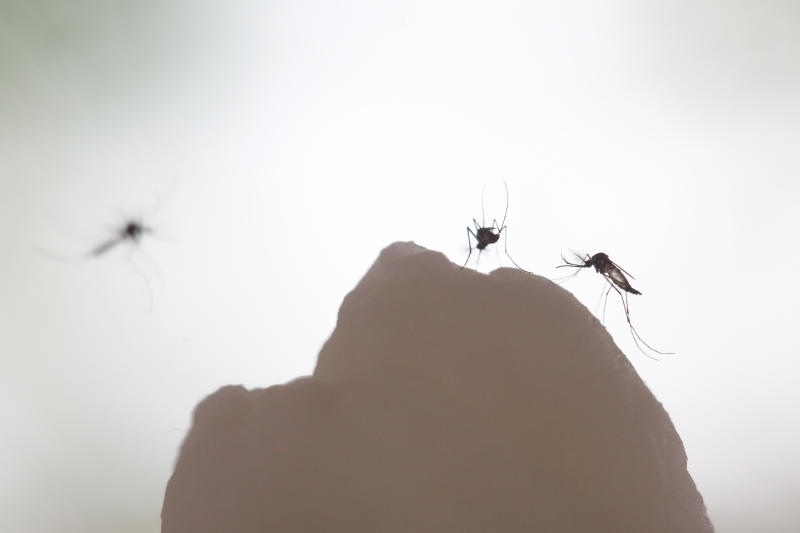Aedes mosquito population down 80 per cent in Nee Soon East cluster after release of sterile male mozzies
Sign up now: Get ST's newsletters delivered to your inbox

From April 2018 to January 2019, the NEA saw an 80 per cent fall in the Aedes mosquito population in a research area in Nee Soon East.
PHOTO: ST FILE
Cheryl Teh
Follow topic:
SINGAPORE - The population of dengue-carrying mosquitoes in Nee Soon East and Tampines West has been cut by at least half after the release of sterile male mosquitoes, which produces eggs that cannot hatch. And this success will see the scheme, labelled Project Wolbachia after the genetically modified males, expanded to wider areas in the two estates.
From April 2018 to January 2019, the National Environment Agency (NEA) saw an 80 per cent fall in the Aedes mosquito population in a research area in Nee Soon East. The population was halved in the Tampines West study site, the agency said on Wednesday (Jan 30).
Still, "it is not a magic bullet" that will solve the mosquito problem, said Associate Professor Ng Li Ching, director of the NEA's Environmental Health Institute. "It will complement what we are doing: source reduction, mozzie wipeout, and removing as many mosquitoes as possible from the community."
Dengue continues to be a perennial problem for Singapore. There were 455 cases reported in just the first two weeks of January 2019 - triple the number reported over the same two week period in January last year.
The Wolbachia-Aedes mosquitoes' job is to control and reduce the Aedes aegypti mosquito population, the primary species responsible for transmitting dengue and Zika. Eggs produced from the union of a male Wolbachia-Aedes mosquito and the female Aedes mosquito will not hatch. This limits the number of mosquito larvae each female Aedes mosquito can produce.
Research on the project started in 2009, and the first phase of the field studies started in 2016. The first small-scale field studies in Braddell Heights, Nee Soon East and Tampines West aimed to understand the behaviour of the Wolbachia-carrying Aedes aegypti in the urban environment, for instance, how far and high they fly, and how well they could compete with their wild counterparts to mate with females.
The second phase - from April 2018 to January 2019 - involved a total of 76 blocks, comprising about 7,000 households. The agency also released the Wolbachia mosquitoes at higher floors, as only 6 per cent of the adult male Wolbachia-carrying mosquitoes released at the ground floor were later found on the ninth floor level and higher.
The next phase, which will start in February this year, will see a doubling of the number of HDB blocks where the Wolbachia-Aedes mosquitoes are released.
"The data that has been generated through the different phases of the field study is essential in developing an effective long-term mosquito suppression programme for Singapore," said Professor Ary Hoffmann, Laureate Professor at the University of Melbourne.
He is a member of Singapore's Dengue Expert Advisory Programme (DEAP), which comprises experts on vector-borne diseases from Australia, Singapore, the United Kingdom, and the United States.
Decreasing the population of Aedes mosquitoes drastically might be possible in the long run, said Prof Hoffmann, who cited the example of a study in Guangzhou, where the mosquito population was reduced by 99 per cent.
But Singapore faces different challenges, he said.
Compared to the urbanised, high-rise environment here, one to two-storey buildings were prevalent in Guangzhou, which made it easier to control the population.
In the third phase, researchers will look into how many male Wolbachia-Aedes mosquitoes should be released to maintain a low Aedes mosquito population. The agency will also adjust the number of mosquitos along the way if more need to be released - to maintain the current mosquito population, or to suppress higher numbers in the expanded area.
They will also develop the production and release of these Wolbachia mosquitoes on a large scale.
Six of these male Wolbachia-Aedes mosquitoes are currently released weekly, for every person in the study area.
The NEA said on Wednesday that the improved results from phase two are due to the expanded area of study sites and the Wolbachia mosquitoes being released at higher floors, in addition to ground floor releases.
In the third phase of the project, which is set to begin in February, mosquitoes will be released weekly at 84 blocks in Nee Soon East and 60 blocks in Tampines West.
With this expansion, the study will involve the largest number of households since it started - with 31,272 in Nee Soon East, and 21,626 households in Tampines West.
Mosquitoes will continue to be released around the HDB blocks, and along common corridors, but not in homes.
Residents at the field study sites might notice an increase in mosquitoes during the field study, but these male mosquitoes released will not bite or transmit diseases, NEA said.

